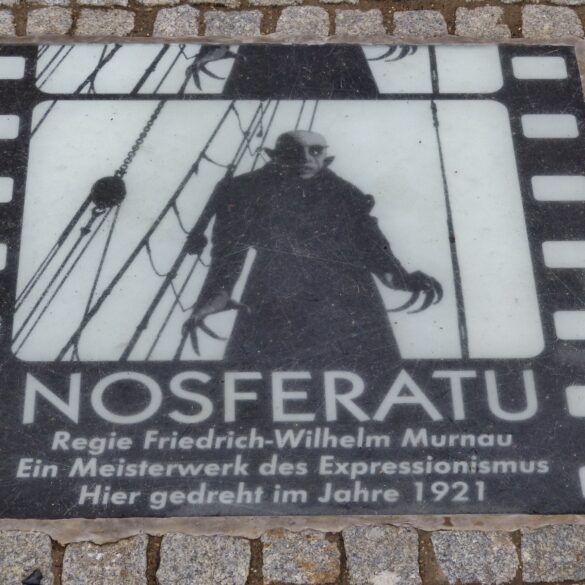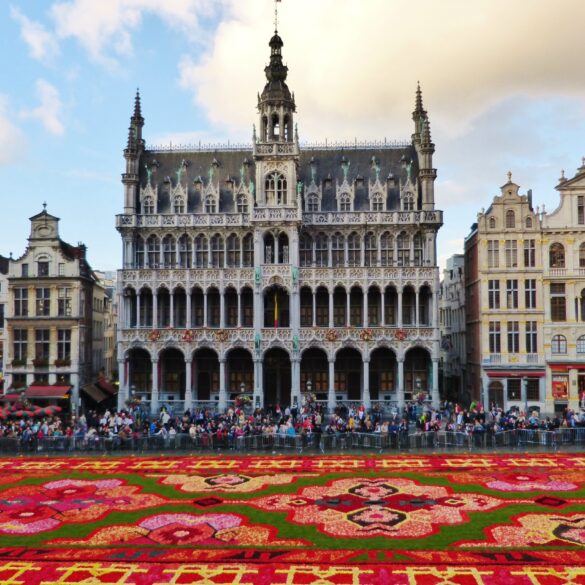The biggest funfair on the Rhine, called the Rheinkirmes in German, takes places every July in Düsseldorf.
We had wanted to go to Düsseldorf anyway, so we used the excuse of the funfair. (As a side note, I had never heard the term “funfair” before moving to Europe. Where I’m from they’re just called fairs. Is there a need to add “fun” to the word? Is there such a thing as a seriousfair? But I digress.)
Sean also had another reason for wanting to go, and that’s because he watched the TV show Hogan’s Heroes as a kid. He says they were always talking about bombing the ball bearing factory in Düsseldorf on the show.
Düsseldorf was in fact badly damaged during World War II.
Scarily, only a week or so before this blog was posted, a World War II bomb was found in Dusseldorf and about 4,000 people had to be evacuated before it was detonated. It was a U.S. bomb that weighed over 1,000 pounds.
This actually happens quite a bit in Germany, even almost 70 years after the end of the war.
We headed up there on a Thursday night after work and checked into the hotel, which was a very convenient Ibis next to the main train station.
Friday morning we got up bright and early and took the train over to the festival area.

We actually got there before the festival opened for the day so we got to walk around the grounds with almost nobody else there. I would have loved to have done that as a kid and it was just as much fun as an adult.
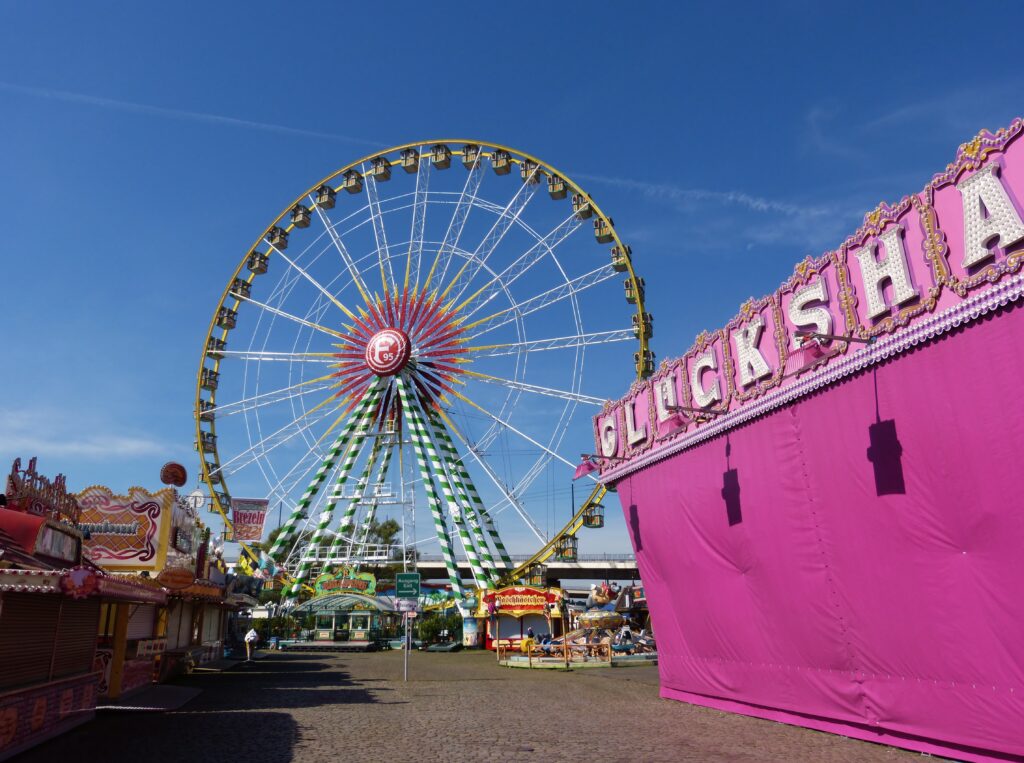
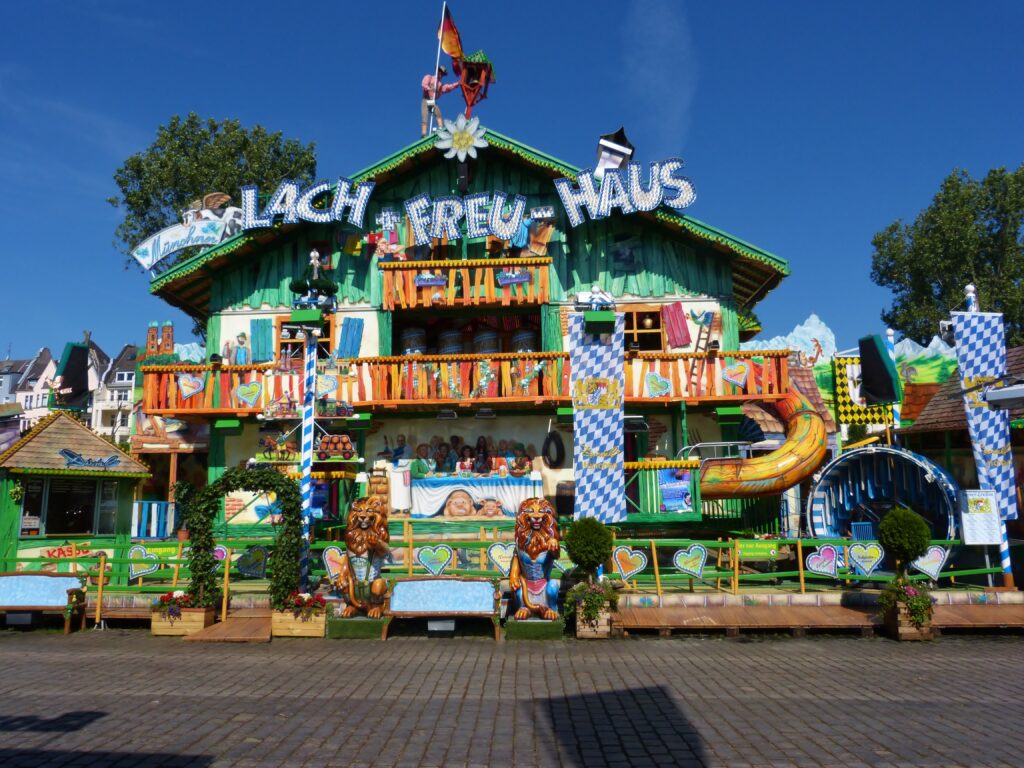
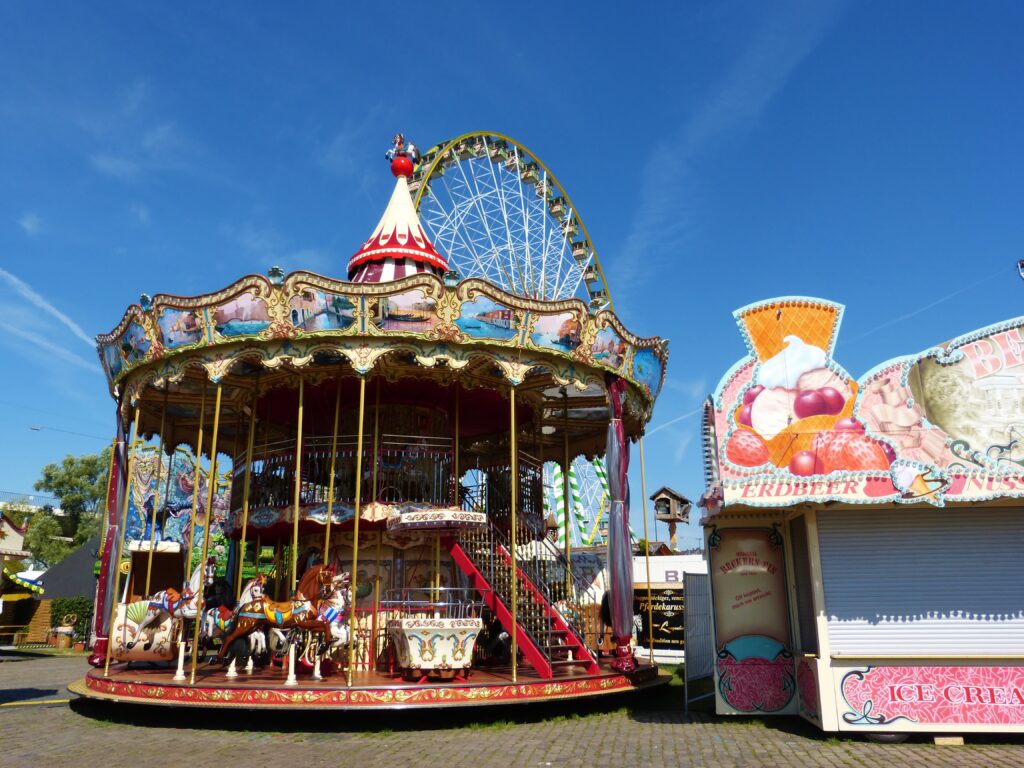
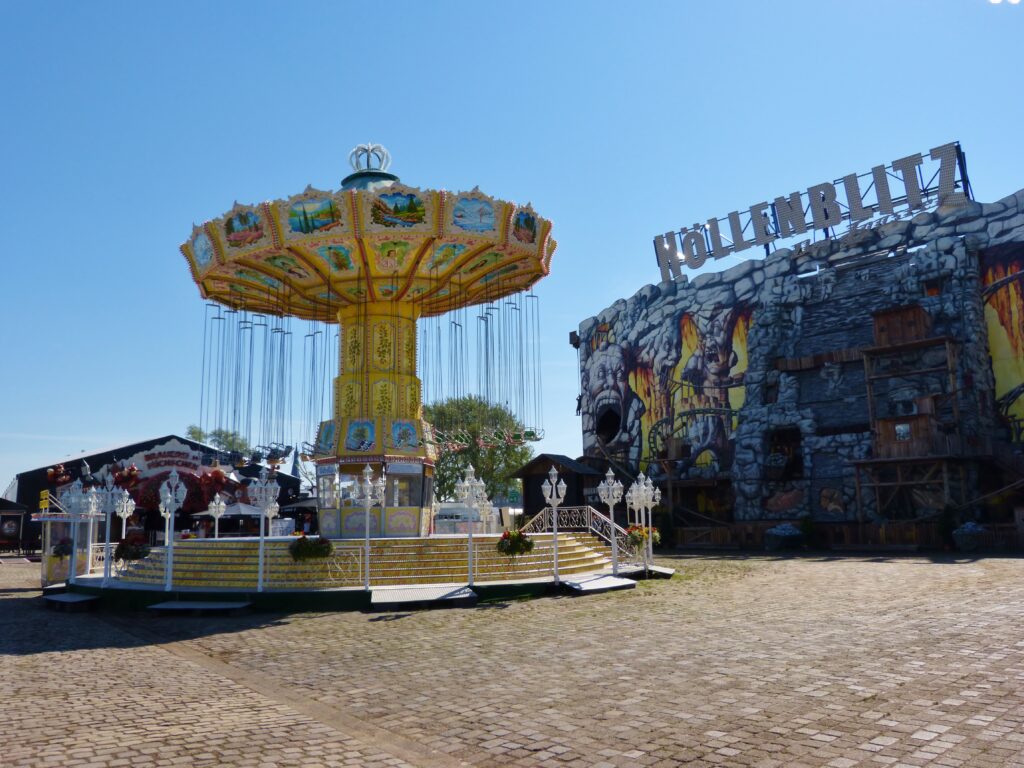

Rather than waiting around for the festival to open, we took the train back to the other side of the river and took a stroll along the Rhine promenade.
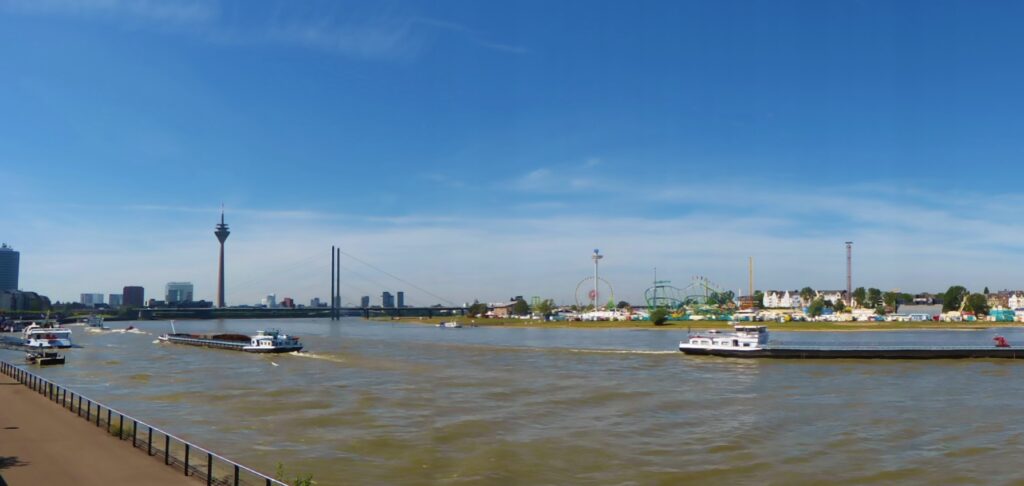
You can see the festival rides across the river.
We also walked around the old town area and our first stop was the St. Lambertus Basilika.
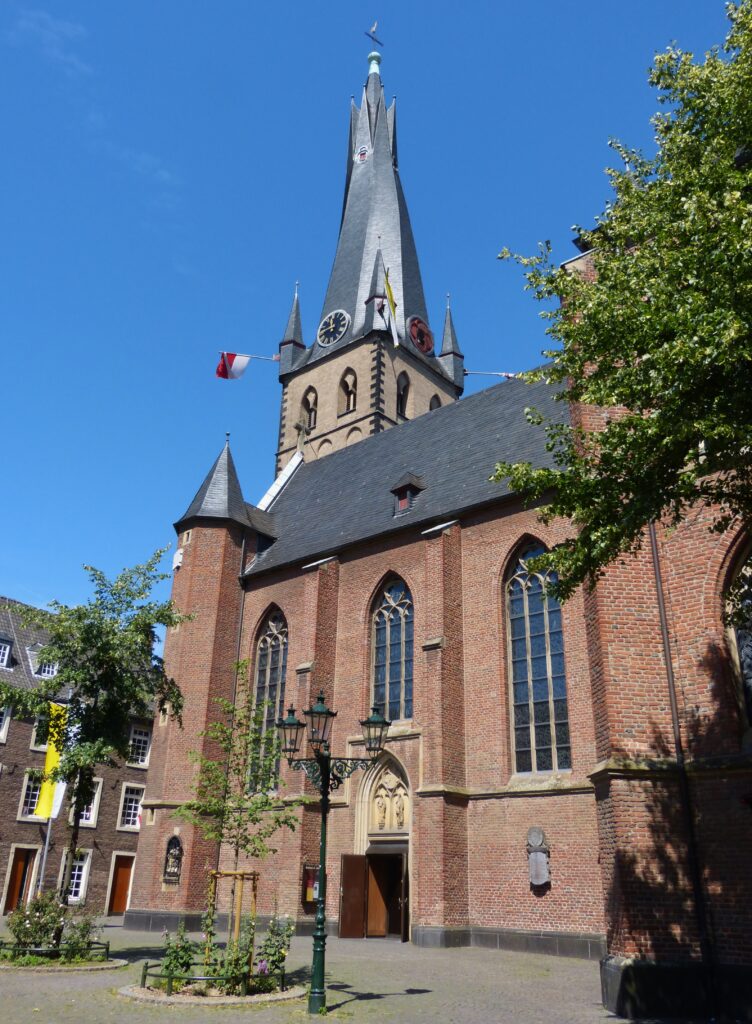
You may be able to see that the spire twists around towards the top. Legend has it that a certain bride, who claimed to be a virgin, approached the altar in a white wedding gown. The tower was so ashamed that it turned aside. Supposedly it will straighten itself out if and when a real virgin ever shows up at the altar.
We saw several of these “pillar saints” around town.

There are nine of them in all, and that one is called “Couple 1”. The saints are all life-size statues created by artist Christoph Pöggeler and each one is located on top of an advertising column. Some of them can kind of take you by surprise when you glance up and see what you think are real, live people standing on top of these columns.
The Marktplatz or market place is the central square in Düsseldorf.

It is surrounded by historic buildings and contains the Jan-Wellem Memorial, the equestrian statue that you see. Jan-Wellem was a Prince Elector whose court sculptor had a house on the Marktplatz.
The beautiful Town Hall building lines one side of the square.

You are in for a treat because we had two Tipples of the Day during our walk.
The first was an Altbier that we had at a brewery called Zum Schlüssel.

Düsseldorf is known for its Altbier, a top-fermented beer. That method of brewing beer is older than the bottom-fermented method, and that’s what gives Altbier or “old beer” its name. It’s dark in color, as you can see, but doesn’t taste like dark beer. It had a much lighter taste than either of us expected.
There are several breweries around town that brew Altbier on site, and Zum Schlüssel is one of them.
The second Tipple of the Day was a Killepitsch.
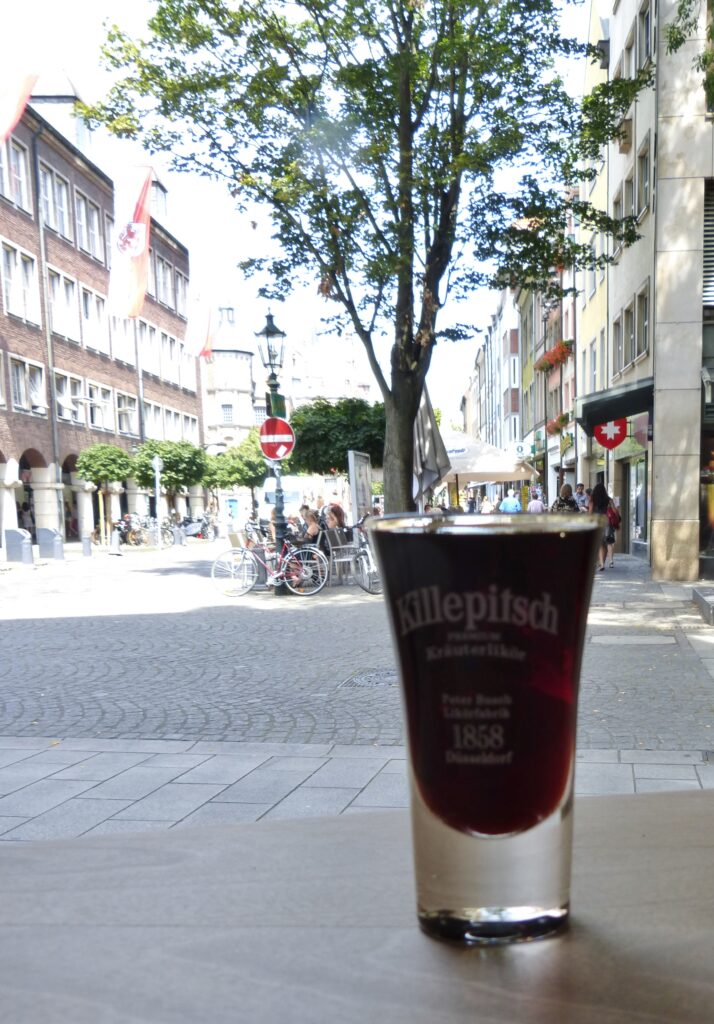
It’s a liquor made in Düsseldorf from a combination of 90 herbs, spices, fruits and berries. I was expecting it to taste medicinal but it didn’t at all and was actually pretty good.
The tiny bar where we got it had an open window with a counter on the street side, so you just walk on up and order your shot and drink it at one of their outdoor tables. I imagine it would be nice on a cold day to warm your innards a bit.
Another thing that’s made in Düsseldorf is Löwensenf mustard.
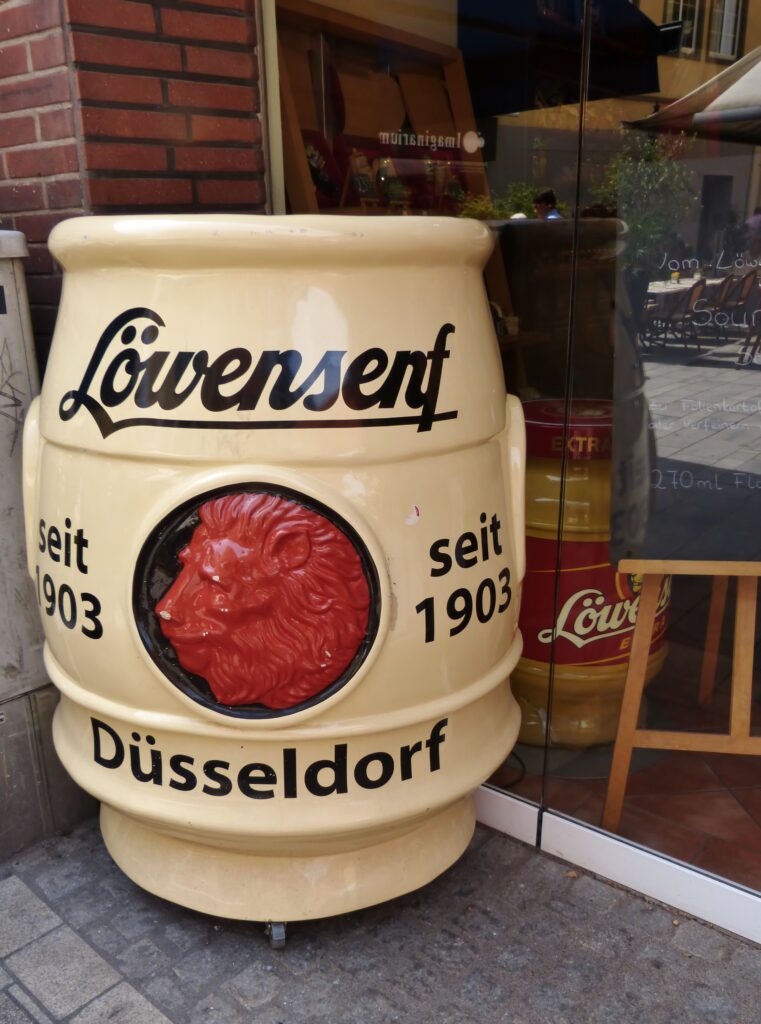
I like taking photos of things called Löwen-whatever, because Löwen means “lions” and our last name is Lyons.
That giant mustard jar was outside of a Löwensenf store which contains a small mustard museum. We popped in to see all kinds of old mustard jars, mustard seeds and mustard-making equipment.
Napoleon ate here!
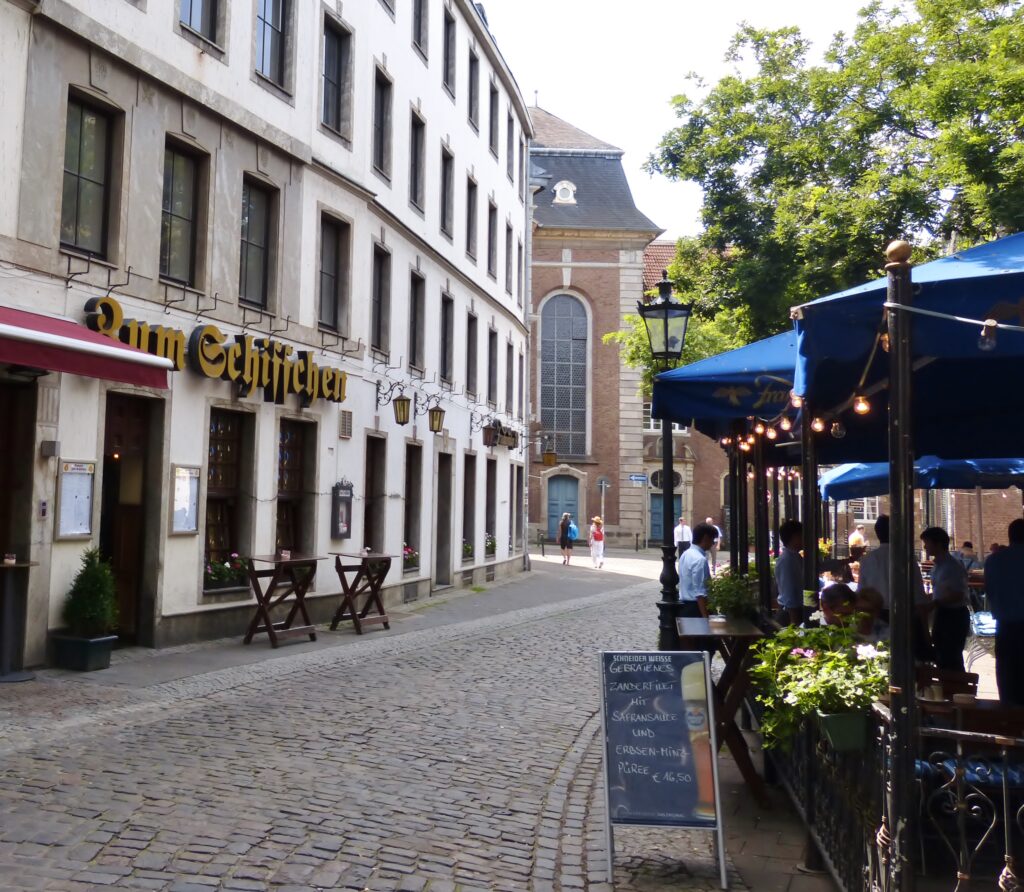
Well, he visited the Zum Schiffchen restaurant anyway. I’m just assuming he had something to eat while he was there.
The statue seen here, of a little girl holding a ball, is near a little harbor not far from the Zum Schiffchen restaurant.

It’s a memorial to the Sinti and Roma gypsies who were murdered during World War II. The status is called Ehra after a real girl who had served as a model for the sculptor Otto Pankok before she was deported to a concentration camp. She actually survived; the statue commemorates those who did not.
You see a lot of these in Germany.
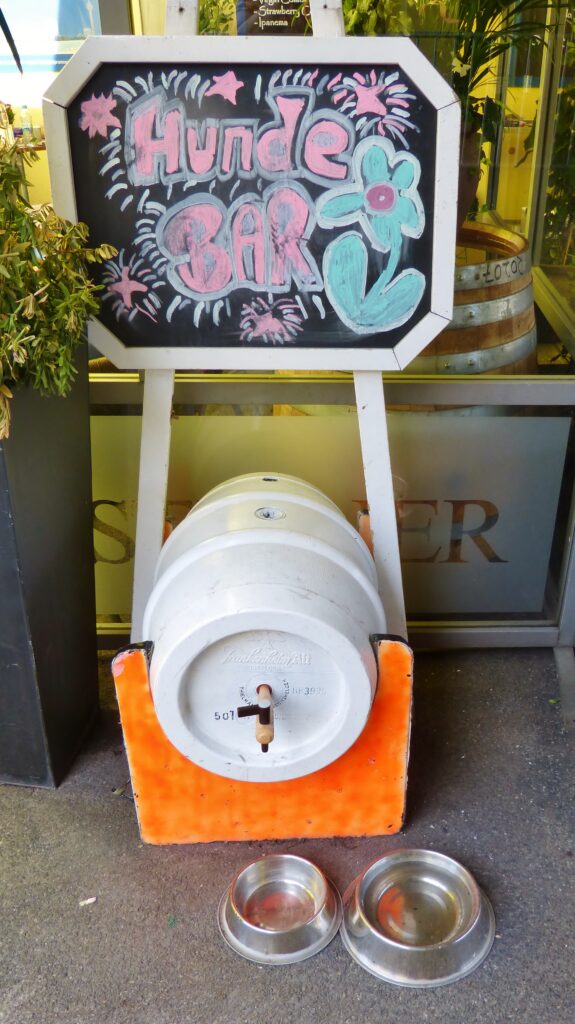
It’s a “dog bar” with bowls of fresh, cool water. It was very hot during our visit so this was nice to see.
Not far from the dog bar was this people bar.
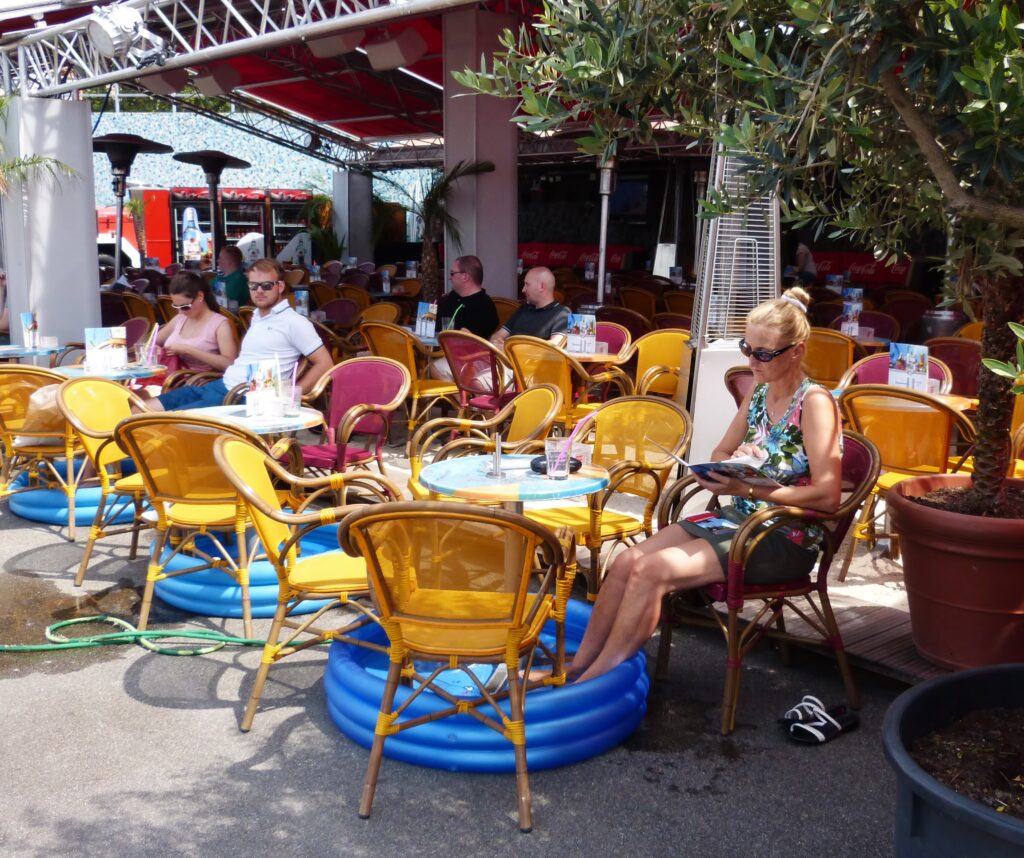
The back part of it that you can’t see was covered in sand. The front part had little pools of water for people to soak their feet in. Nice idea in theory but I couldn’t do it unless I saw them changing the water and cleaning the pool first. Other people’s feet gross me out.
Cartwheeling children are a symbol of Düsseldorf.
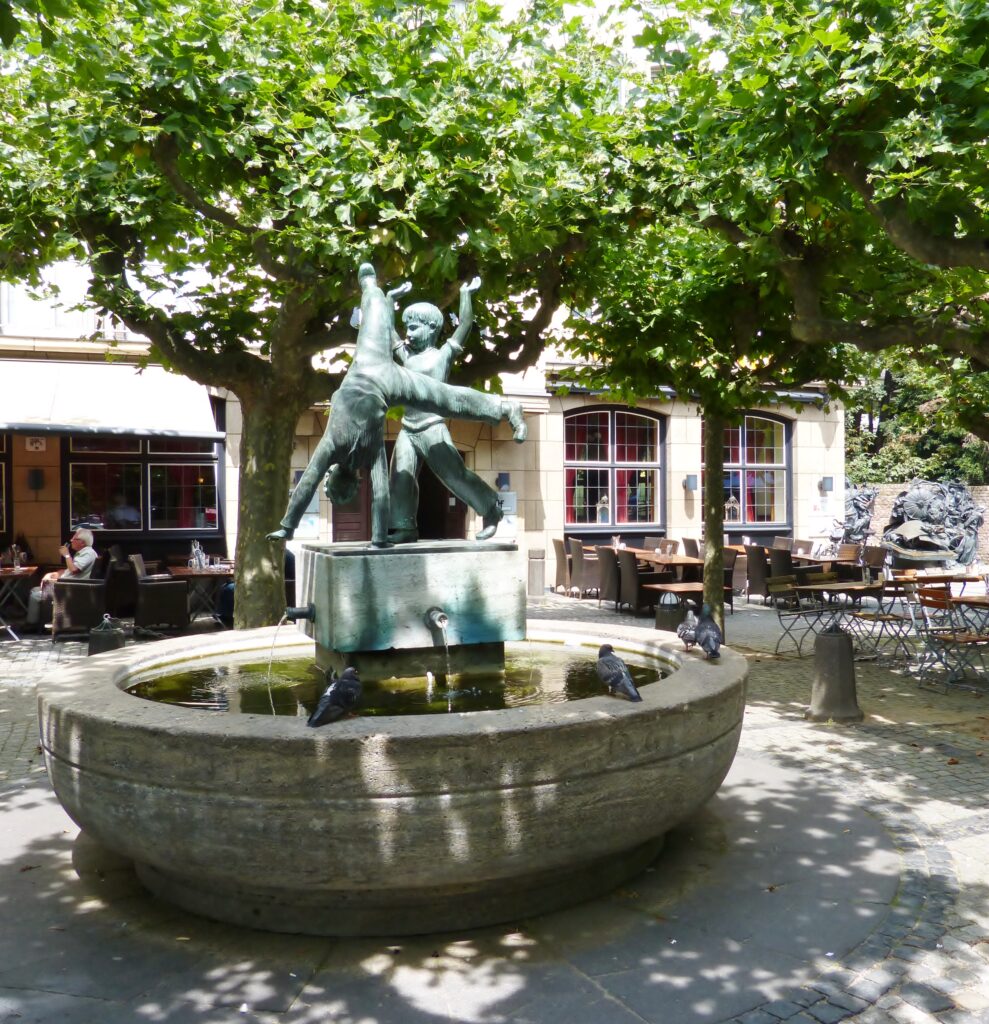
You see them on the manhole covers and this fountain depicts them as well. Apparently after Düsseldorf won the Battle of Worringen in 1288, everyone was thrilled and the children started cartwheeling in celebration.
This rather hideous (just my opinion, of course) sculpture commemorates the occasion of Düsseldorf being proclaimed a city.
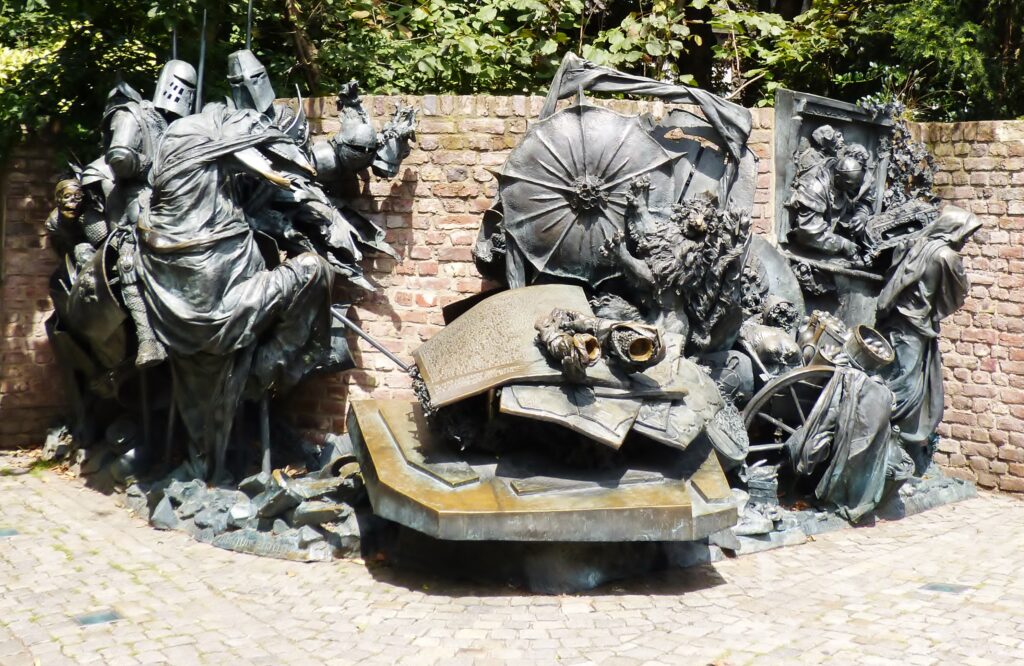
City rights were obtained after the aforementioned Battle of Worringen was won. If you look closely at the sculpture, you can see the head of one of the horses looks like a skeleton and behind that is a representation of a human skeleton. Even though a battle was involved in obtaining city rights, you’d think they’d want something a little more cheery to celebrate the occasion.
This little canal runs along Königsallee, a famous shopping street in Düsseldorf.

The back of the sculpture you see is of the sea god Triton.
Did I mention that it was really, really hot when we were there? I was thankful for the shade along the canal and for the benches that were thoughtfully placed there.
Right after we’d seen the cartwheel fountain we’d stopped at a restaurant for some drinks. Sean had another Altbier and we each had a .75-litre bottle of water.
By the time we reached Königsallee a short while later we were both hot, sweaty and thirsty again so we stopped for some ice cream and some more water.
And about 5 minutes after that we sat on a bench by the canal and relaxed in the shade. We are not hot-weather people, in case that wasn’t clear.
This fun little fountain is called the Musikbrunnen or Music Fountain.

On all sides of it are sculptures of figures playing musical instruments. There you can see a horn-player and a drummer.
I mentioned that it was hot as hell that day, right?

See? Even the dogs were eating ice cream because it was so hot!
This little bronze sculpture depicts Tailor Wibbel, who is apparently a character in an opera of the same name.
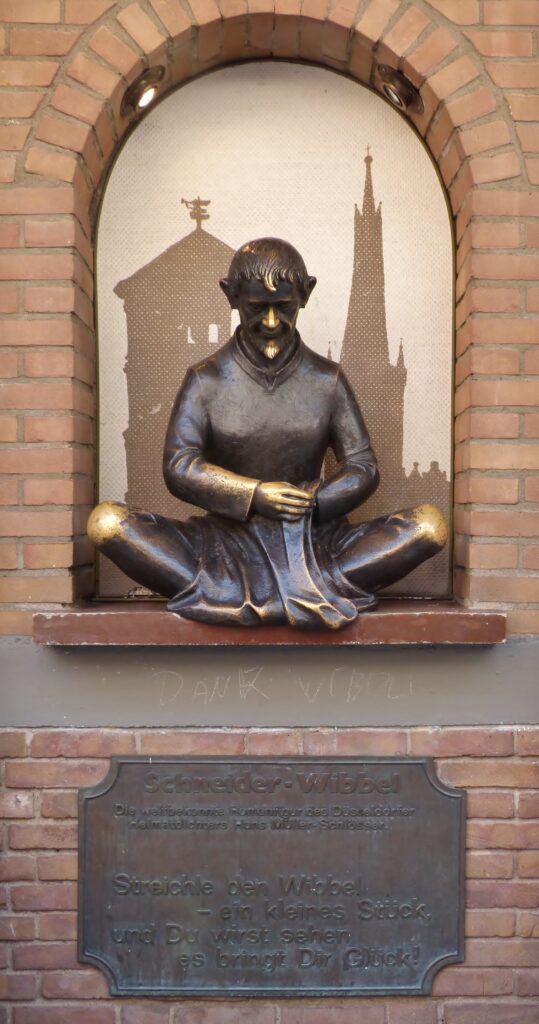
The walking tour brochure we had said “Here, you are advised to stroke Tailor Wibbel, as it will bring you luck.” Ummm, uhhh, hmmm..….how about if I just rub his knee like everyone else seems to have been doing?
After our walking tour we went back to our thankfully air-conditioned hotel and cooled off.
We went back out that evening to watch the fireworks over the Rhine to mark the end of the 2014 funfair.

We never even made it back to the funfair, so basically we just saw it before it opened. It was okay though because during our walking tour we could see how crowded it was and we decided to skip it. I was more interested in the fireworks anyway.
By the time we got back to the hotel it was fairly late so we called it a night, but if we’d wanted to stay out and party we’d have had no trouble doing that.
Düsseldorf’s old town area is nicknamed “The Longest Bar in the World” with over 300 places to get a drink. Supposedly the bar counter in each establishment is connected to the bar in the adjoining building(s).
We walked through the area during the day and it wasn’t bad, but we also walked through going to and from the fireworks and it was insanely crowded. We said “Maybe next time.”
The next day we headed home but made two quick stops along the way.
The first stop was in Duisburg to see this bizarre fountain.

It’s called the Lifesaver fountain and as you can see it’s a giant bird-like creature with a giant woman straddling it. The fountain was quite controversial when it was installed, as you might imagine.
The second stop was also in Duisburg to check out the Tiger and Turtle sculpture.

It’s supposed to look like a roller coaster and it does in fact look like one. There are stairs on it and you can walk around it except for the loop part.
There’s Sean walking inside the sculpture.
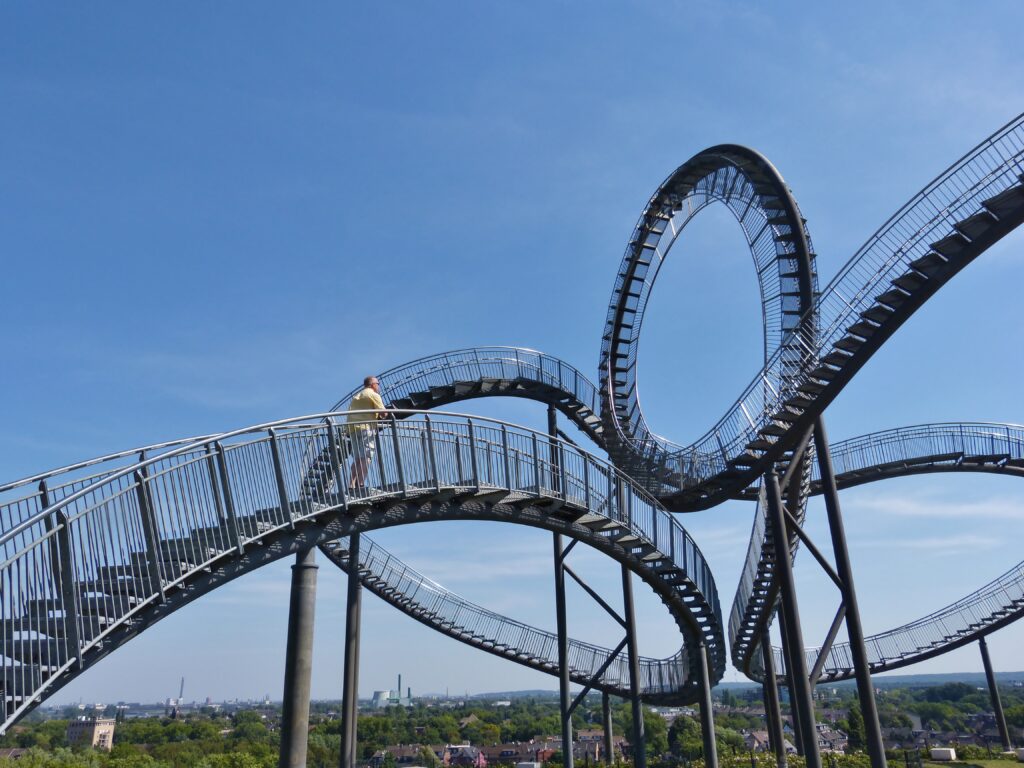
I walked it as well and it’s a lot more nerve-wracking than it looks.
Aside from the oppressive heat it was a great weekend and I was pleasantly surprised by how nice the city was.

